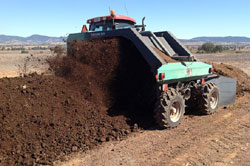



Adding Value to Poultry Litter
AUSTRALIA - Poultry farmers are consistently looking at ways to reduce costs, increase farm efficiencies and maximise their return on investment. For many, the management of poultry litter is one aspect of their operations that presents its own challenges.
For fertiliser use, spent litter is commonly perceived as bulky, having an inconsistent nutrient content, and there are concerns that use as a land applied fertiliser may result in environmental damage due to nutrient leaching or run-off.
While not in the required ratios, poultry litter does contain the range of critical nutrients commonly applied as inorganic fertiliser (e.g. N-nitrogen, P-phosphorus and K-potassium). In litter, these nutrients occur in slow release forms and are accompanied by a substantial input of biologically active carbon. Litter effectively provides a feedstock for microbial biomass nutrient conversion activities, resulting in the retention of nutrients in forms with much longer persistence in soil than can occur with inorganic fertilisers.
A project being run by Poultry CRC researcher Dr Matthew Redding’s aims to overturn negative perceptions of spent litter. This will be achieved via the development of waste stream value-adding strategies that minimise nutrient losses to the environment while providing better nutrient supply characteristics than traditional fertilisers. By incorporating bentonite and other ‘smart sorbers’ (synthetic clays) into litter, Matthew aims to improve the fertiliser value of the material from the outset. Dr Redding and his collaborators (Professor Steve Walkden-Brown and Dr Fakhrul Islam from the University of New England) have found that as an added bonus, laboratory volatilisation trials have indicated that bentonite as a bedding material, combined with spent wood shaving-based litter, decreases ammonia volatilisation relative to the spent litter alone and may (if applied in-shed) improve air quality and bird productivity.
Dr Redding explained, “Industry interest has already been generated with regard to further trials of bentonite as a bedding material. If we can put bentonite into the shed either as an improvement to existing conventional bedding, or partial or full replacement for bedding, then we can offset the cost of purchasing that ingredient in the fertiliser by reducing our costs in bedding or improving production.” In addition, the availability of bentonite is good in many areas of Australia, particularly South East Queensland, as it is found alongside coal deposits.
“From my point of view, any material like spent litter where your N and P are in organic forms rather than inorganic has potential to be a good base for superior fertiliser, where loss to the environment (e.g. via leaching) can be minimised” he said. Results thus far support a number potential approaches to the use of smart sorber / spent litter formulations as fertilisers. These include:
- Spent litter with smart sorber additions could be considered as two elements of a more complete fertiliser formulation, including addition of inorganic P (e.g. up to 20 per cent of total P). This approach could also deliver the benefits of a balanced and tailored fertiliser product that may well aid marketability.
- Increasing the initial application rate of spent litter / smart sorber may achieve the same ends, while not resulting in the P losses that would occur with large single applications of inorganic P.
- Decreasing the treatment rate of smart sorber in the spent litter. This would also serve to decrease the cost of production. “Preliminary experimentation suggests that rates between 10 and 20 per cent on a dry-mass basis would likely be appropriate in decreasing P losses” added Dr Redding.
The potential market for spent poultry litter fertiliser products clearly exists. This research will give poultry farmers robust tools with which to work in the development of a market-ready resource that can help reduce overall farm costs, have positive environmental impacts and aid other agricultural sectors.









